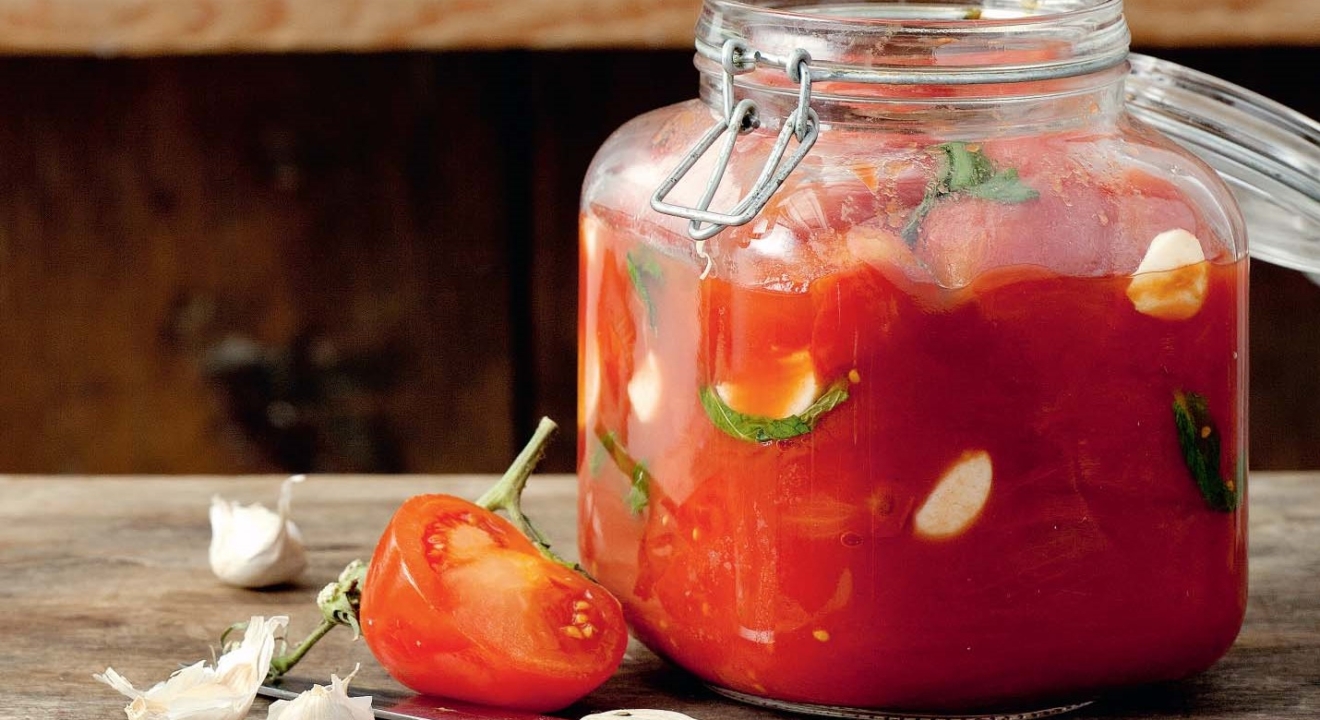Tomato preservation in jars and freezer
ARGIRO BARBARIGOU

A full guide to tomatoes and everything you need to know about keeping them fresh for longer, or how to preserve them once they ripen: tomato sauce in the freezer, jarred tomato sauce with herbs, freezing whole tomatoes, making sun-dried tomatoes in oil, freezing cherry tomatoes, homemade tomato paste in jars, and much more… all covered here!
Tomatoes are a staple of the Greek summer. Aromatic, fleshy, fragrant, and in abundance during the peak of the season. They’re ideal for salads, cooking, or sauces.
When you have a surplus, that’s the time to preserve them in jars or freeze them. Traditional and easy preservation methods are detailed below, with just a little prep.
The key is how to keep fresh tomatoes longer and then how to preserve them in jars or freeze them once they ripen.
Buying and storing tomatoes
To keep fresh tomatoes longer, store them at room temperature. Refrigeration is their enemy. Tomatoes love warmth; in the fridge, they stop ripening, their flesh turns watery, and they lose their sweetness, flavor, and aroma.
To help them ripen properly, line a tray with paper towels and spread out the tomatoes without touching each other, about half a centimeter apart.
Place them stem side up. Depending on ripeness, they’ll keep 3-5 days at room temperature until they’re sweet and ready to eat.
Freezing tomato sauce
To preserve tomato sauce in the freezer, the best method is to store it in sterilized jars, as outlined below. This allows it to keep for up to one year outside the refrigerator.
Another common method is freezing fresh whole tomatoes instead of sauce. The same applies to cherry tomatoes.
Choose firm, unblemished tomatoes. If they will not be used immediately, leave the stems intact. If preparing them for sauce, wash, dry, and remove the stems.
Tomatoes may be peeled and then blended. If using a tomato press that separates skins and seeds from the flesh, blend them whole. Use a food mill or blender for large quantities; for small amounts, a grater works well, naturally separating the skin from the pulp.
Tomato stems can be used to add fragrance to stews or roasts, then removed after cooking.
Traditional method for canning
Boiled tomato sauce. Ideal varieties include pomodori, Roma, or elongated cherry tomatoes with dense flesh and low moisture content.
A home tomato press, resembling a food mill, separates skins and seeds from the pulp, producing a thick, smooth sauce.
After thoroughly washing the tomatoes, remove the stems. Cut into pieces and blend. For some, blanching is preferred beforehand. Process through the tomato press to separate skin and seeds from the pulp. If needed, repeat the process to extract all usable flesh from the skins.
Transfer the tomato to a large pot and bring to a boil over high heat. Add 1 heaping tablespoon of coarse salt, reduce the heat, and simmer over medium heat for about an hour, until the sauce reduces by half and thickens.
While still hot, pour the sauce into sterilized jars, filling to the brim. Seal tightly with sterilized lids.
Invert the jars on a towel with the lids facing downward. This helps release any trapped air and ensures a proper vacuum seal as the contents cool.
Properly sealed, the jars can be stored in a cool, dark place for up to one year. Once opened, the remaining sauce should be refrigerated and used within a few days.
For a more concentrated tomato product, the sauce may be cooked further until reduced to one-third of its original volume, resulting in a texture between sauce and paste.
Sun-dried or semi-dried tomatoes in oil can be preserved using this method.
Simplified Canning Method
Grated tomatoes jarred for year-round use. Best varieties include pomodori, Roma, or elongated cherry tomatoes, which have minimal moisture, thick flesh and thin skins.
Wash and remove stems. Cut into pieces with skins on and blend. Transfer to a wide, heavy-bottomed pot and add 1 tablespoon coarse salt.
Bring to a boil over high heat. Once boiling, cook over medium to high heat for 30 minutes. Ensure jars and lids are sterilized and kept warm. The tomato must be hot, same goes for the jars.
Fill the jars to the brim while the sauce is still hot. Seal tightly with the lids. Invert the jars on a surface so the lids face down. Allow to cool completely to room temperature.
Store the jars in a dark cupboard. They will keep for many months, up to a year. Once opened, the remaining sauce should be refrigerated and consumed within 2 to 3 days.
Lid and Jar Sterilization
For long-lasting results, both jars and lids must be thoroughly sterilized. Avoid using old lids that do not seal properly or show interior spotting, as they may compromise the preservation.
If a jar fails to seal, this will become apparent on the lid once cooled. Improper sealing may trap air, shortening the sauce’s shelf life. In this case, the contents should be reheated to a boil and transferred to a new, sterilized jar with a secure lid.
Tomatoes in the freezer
Freezing grated tomatoes is perhaps the easiest method of preservation. Tomatoes can be peeled and seeded using a press, but if using low-moisture varieties such as Roma or elongated cherry tomatoes, this step can be skipped.
Wash and grate or blend the tomatoes. Fill freezer-safe bags, seal airtight, and freeze.
During peak summer, island-grown dry-farmed tomatoes can be frozen whole. These are ideal for tomato fritters with excellent aroma and flavor year-round.
Dry-farmed tomatoes are small, irregularly shaped, intensely aromatic, low in juice, and thick-fleshed. Roma and elongated cherry tomatoes are also ideal for freezing due to their firm flesh and rich flavor.